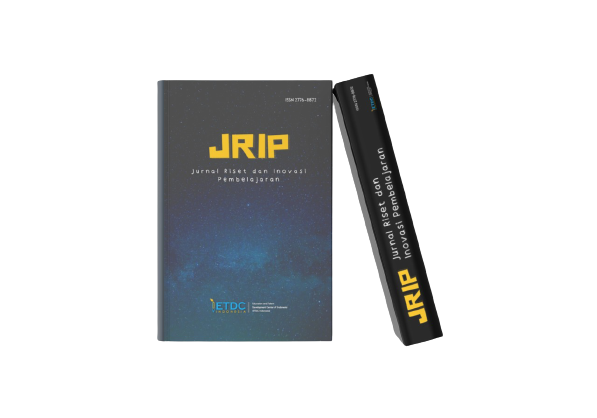Konten TikTok Sebagai Media Pembelajaran Pendidikan Agama Islam Di SMP
https://doi.org/10.51574/jrip.v4i1.1333
Keywords:
Media Pembelajaran, Pendidikan Agama Islam, Konten TikTokAbstract
Learning media is used for the learning process, one of which is learning Islamic Religious Education in Schools. Various types of learning media can be used today due to technological developments. The learning media referred to is the use of TikTok content in learning Islamic Religious Education in schools. This research attempts to conceptually describe the use of TikTok content as a learning medium for Islamic religious education in junior high schools. A qualitative approach and qualitative descriptive methods were used in this research. The findings that the researchers obtained were that the characteristics of TikTok content were in accordance with Islamic Religious Education teaching materials from the aspects of simplicity, integration, color, texture, lines, emphasis, balance, shape and attractiveness. Stages of selecting content according to Islamic Religious Education teaching materials based on objectivity, learning program, program targets, technical quality. TikTok content is in accordance with teaching materials for Middle School Islamic Education, including 10 content for class VII PAI teaching materials, namely faith in Allah, honesty and istiqamah, taharah, congregational prayers, the life journey of the Prophet, faith in angels, Friday prayers, plural prayers and qasar, hijrah Rasulullah, Khulafaur Rasyidin. There are 11 contents for class VIII PAI teaching materials, namely Faith in the Book of Allah, alcohol, honest and just behavior, Sunnah prayers, prostration (sahwi, thanksgiving, prayer mat), Umayyad Dynasty, simple life, stories of 25 prophets and apostles, deeds to people old age, fasting, halal and haram food and drink. There are 5 contents for PAI class IX teaching material, namely the end of the world, procedures for aqiqah, sacrifice and slaughter, the entry of Islam in Indonesia, Qada and Qadar, Hajj and Umrah. The process of designing Islamic Religious Education Learning Media by utilizing TikTok content starts from planning, material development, presentation and evaluation.
Downloads
References
Ainiyah, N. (2018). Remaja Millenial dan Media Sosial: Media Sosial sebagai Media Informasi Pendidikan bagi Remaja Millenial. Jurnal Pendidikan Islam Indonesia, 221–236.
Barni, M. (2019). Tantangan Pendidik di Era Millenial. Jurnal Transformatif Volume 3, Nomor 1, 99-116.
Bohang, F. K. (2018). Tik Tok Punya 10 Juta Pengguna Aktif di Indonesia. Jakarta: Kompas.com. Retrieved September 10, 2018, from https://tekno.kompas.com/read/2018/07/05/09531027/tik-tok-punya-10-jutapengguna-aktif-di-indonesia .
Budiman, H. (2017). Peran Teknologi Informasi dalam Pendidikan. AlTadzkiyyah: Jurnal, 31-33.
Depdiknas. (2019). Panduan Implementasi Standar Proses untuk Satuan Pendidikan Dasar. Jakarta.
Firdaos, R. (2019). Pedoman Evaluasi Pembelajaran. Bandar Lampung: CV. Anugrah Utama Raharja.
Halim, M. B., & Yusuf, A. Z. (2020). Pengembangan Media Pembelajaran Berbasis Jejaring Sosial. Jurnal Media Elektrik, Vol. 18, No.1, 16.
Husamah, H., Wahyono, P., & Budi, A. S. (2020). Guru profesional di masa pandemi COVID-19: Review implementasi, tantangan, dan solusi pembelajaran daring. Jurnal Pendidikan Guru Profesi, 51-65.
Kurniawati, & Ika. (2011). Pengujian Prototipe Media Pembelajaran. Jakarta: Modul Diklat PTP-Pustekkom Kemdikbud.
Manshur, U., & Ramdhani, M. (2019). Media Audio Visual Dalam Pembelajaran. AL MURABBI: Jurnal Pendidikan Agama Islam Volume 5 Nomor 1, 3.
Oktavia, Y., & Hulu, F. (2017). Pengaruh Metode Quantum Learning Berbasis Media Interaktif Terhadap Prestasi Belajar Bahasa Indonesia Mahasiswa di Universitas Putera Batam. Jurnal Keilmuan Bahasa, Sastra dan Pengajarannya, 255–269.
Rasdin, R., Mulyat, Y., & Kurniawan, K. (2021). Fenomena TikTok sebagai Media Komunikasi Edukasi. Riksa Bahasa XV, 230-232.
Rohmah, N. (2021). Media Pembelajaran Masa Kini: Aplikasi Pembuatan dan Kegunaannya. Awwaliyah: Jurnal PGMI, Volume 4 Nomor 2, 128-129.
Santyasa, W. (2007). Landasan Konseptual Media Pembelajaran. Banjar.
Sari, M., & Asmendri. (2020). Penelitian Kepustakaan (Library Research). NATURAL SCIENCE: Jurnal Penelitian Bidang IPA, 43.
Shoffa, S., & dkk. (2021). Perkembangan Media Pembelajaran di Perguruan Tinggi. Jawa Timur: CV. AGRAPANA MEDIA.
Sugiyono. (2019). Statistika untuk Penelitian. Bandung: Alfabeta .
Sukardi. (2014). Metodologi penelitian pendidikan kompetensi dan praktiknya. Jakarta: Bumi Aksara.
Sunandar, D. (2021). Pendidikan Agama dalam Kurikulum Nasional. Jurnal Al Amar Vol.2 No.1, 5-7.
Sya'bani, M. A. (2018). Pengembangan Kurikulum Pendidikan Agama Islam dalam Perspektif Pendidikan Nilai. Jurnal Tamaddun– FAI UMG. Vol. XIX. No.2, 102.
Syahidin. (2022). Aplikasi Metode Pendidikan Qurani dalam Pembelajaran Agama Islam di Sekolah. Bandung: UPI Press.
Tafonao, T. (2018). Peranan Media Pembelajaran Dalam Meningkatkan the Role of Instructional Media To Improving. Jurnal Komunikasi Pendidikan, 105.
Downloads
Published
How to Cite
Issue
Section
License
Copyright (c) 2024 Izzatul Iffah, Udin Supriadi, Agus Fakhruddin

This work is licensed under a Creative Commons Attribution-ShareAlike 4.0 International License.













